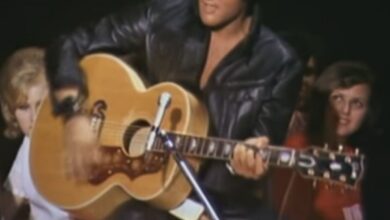This Performance Showcased Elvis As The Epitome Of Talent, Charisma, And Irresistible Looks, Truly Irreplaceable!
“Blue Christmas” has become one of the most iconic holiday songs over the decades, resonating with themes of love, loss, and nostalgia. Originally penned by Billy Hayes and Jay W. Johnson, the song first emerged in the country music realm thanks to Ernest Tubb’s recording in 1948. However, it was Elvis Presley’s rendition that cemented the song’s place in American culture and holiday music. Elvis infused the piece with his unique style, blending country, rock, and blues elements, which contributed to its widespread acclaim.
The song reflects the emotional complexities of the holiday season, capturing a sense of longing and heartache. Its lyrics express the sadness of missing a loved one during the holidays, a sentiment that many can relate to. This emotional depth is part of what makes “Blue Christmas” resonate so strongly with listeners, as it manages to encapsulate both the joy and sorrow that often accompany family gatherings and festive celebrations.
Elvis’s version of “Blue Christmas” features lush instrumentation, including rich string arrangements and a background choir that adds to the emotional weight of the song. This production style helped transform the track into a staple of holiday music playlists. The arrangement complements Presley’s vocal delivery, which balances soft, tender moments with more powerful, soulful passages, showcasing his remarkable range as a performer.
In 1968, the “68 Comeback Special” marked a pivotal moment in Elvis’s career. After a period spent mostly in the film industry and not performing live, this special was a bold return to form. It revitalized his image and reconnected him with his original fan base. The performance of “Blue Christmas” during this special stood out not only because of its nostalgic melody but also due to the context of Presley’s return to live performance.
During the special, Elvis delivered “Blue Christmas” with a captivating presence. The combination of his strong vocal prowess and stage charisma captivated the audience, creating an intimate atmosphere despite the festive setting. He drew the audience in, conveying deep emotion and vulnerability through his expressive singing, all while surrounded by the jubilant energy of the holiday season. This performance has since been regarded as one of the most definitive versions of the song.
Elvis’s interpretations of songs often added a layer of personal touch, and “Blue Christmas” was no exception. His delivery seemed to convey not just the lyrics but also his own experiences of love and loss. As such, the song transcended simple holiday fare; it became a heartfelt expression of human experience that resonated with many generations of audiences. This ability to connect through music is part of why he remains an enduring figure in popular culture.
The legacy of “Blue Christmas” does not end with Elvis. Numerous artists have covered the song over the years, each adding their own flavor while honoring the original spirit. From Bing Crosby to modern artists like Kelly Clarkson and Michael Bublé, the song’s adaptability showcases its classic status and widespread appeal.
Additionally, the song has been featured prominently in various films, television shows, and commercials, reinforcing its status as a quintessential holiday anthem. Its familiarity has made it a go-to choice for Christmas playlists and sing-alongs, further solidifying its place in the canon of holiday music.
Elvis Presley himself enjoyed a prolific career that extended beyond just one holiday classic. Born on January 8, 1935, in Tupelo, Mississippi, he became a cultural icon known as “The King of Rock and Roll.” His music blended a range of genres and influenced countless artists across generations. Throughout the 1950s and 1960s, Elvis released a series of chart-topping hits that showcased his vocal abilities and magnetic personality. Songs such as “Hound Dog,” “Jailhouse Rock,” and “Can’t Help Falling in Love” remain favorites amongst fans worldwide.
Elvis’s impact on music and pop culture is immeasurable. His style, charisma, and innovation paved the way for future generations of artists who would look to him as an example. His interpretation of traditional songs like “Blue Christmas” helped bridge the gap between different musical styles and introduced new audiences to the beauty of classic melodies reimagined through rock and roll.
In the end, “Blue Christmas” stands as a testament to the enduring power of music to evoke emotions and create connections between people, especially during the holiday season. It serves as a reminder of both the joys and the heartaches that often accompany this time of year, making it a beloved classic that continues to touch hearts long after its inception.



